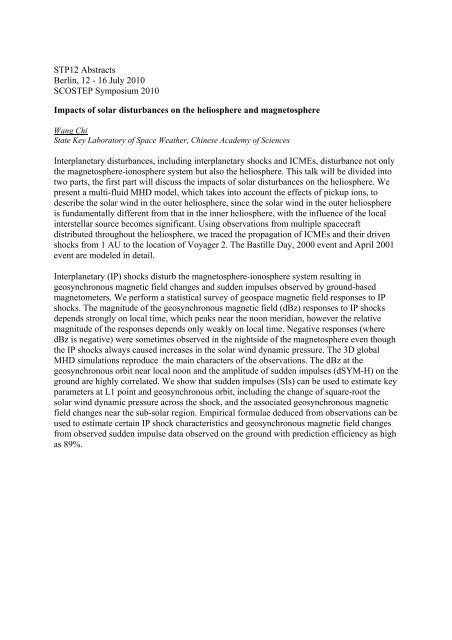scostep 2010 (stp12) - Leibniz-Institut für Atmosphärenphysik an der ...
scostep 2010 (stp12) - Leibniz-Institut für Atmosphärenphysik an der ...
scostep 2010 (stp12) - Leibniz-Institut für Atmosphärenphysik an der ...
Create successful ePaper yourself
Turn your PDF publications into a flip-book with our unique Google optimized e-Paper software.
STP12 Abstracts<br />
Berlin, 12 - 16 July <strong>2010</strong><br />
SCOSTEP Symposium <strong>2010</strong><br />
Impacts of solar disturb<strong>an</strong>ces on the heliosphere <strong>an</strong>d magnetosphere<br />
W<strong>an</strong>g Chi<br />
State Key Laboratory of Space Weather, Chinese Academy of Sciences<br />
Interpl<strong>an</strong>etary disturb<strong>an</strong>ces, including interpl<strong>an</strong>etary shocks <strong>an</strong>d ICMEs, disturb<strong>an</strong>ce not only<br />
the magnetosphere-ionosphere system but also the heliosphere. This talk will be divided into<br />
two parts, the first part will discuss the impacts of solar disturb<strong>an</strong>ces on the heliosphere. We<br />
present a multi-fluid MHD model, which takes into account the effects of pickup ions, to<br />
describe the solar wind in the outer heliosphere, since the solar wind in the outer heliosphere<br />
is fundamentally different from that in the inner heliosphere, with the influence of the local<br />
interstellar source becomes signific<strong>an</strong>t. Using observations from multiple spacecraft<br />
distributed throughout the heliosphere, we traced the propagation of ICMEs <strong>an</strong>d their driven<br />
shocks from 1 AU to the location of Voyager 2. The Bastille Day, 2000 event <strong>an</strong>d April 2001<br />
event are modeled in detail.<br />
Interpl<strong>an</strong>etary (IP) shocks disturb the magnetosphere-ionosphere system resulting in<br />
geosynchronous magnetic field ch<strong>an</strong>ges <strong>an</strong>d sudden impulses observed by ground-based<br />
magnetometers. We perform a statistical survey of geospace magnetic field responses to IP<br />
shocks. The magnitude of the geosynchronous magnetic field (dBz) responses to IP shocks<br />
depends strongly on local time, which peaks near the noon meridi<strong>an</strong>, however the relative<br />
magnitude of the responses depends only weakly on local time. Negative responses (where<br />
dBz is negative) were sometimes observed in the nightside of the magnetosphere even though<br />
the IP shocks always caused increases in the solar wind dynamic pressure. The 3D global<br />
MHD simulations reproduce the main characters of the observations. The dBz at the<br />
geosynchronous orbit near local noon <strong>an</strong>d the amplitude of sudden impulses (dSYM-H) on the<br />
ground are highly correlated. We show that sudden impulses (SIs) c<strong>an</strong> be used to estimate key<br />
parameters at L1 point <strong>an</strong>d geosynchronous orbit, including the ch<strong>an</strong>ge of square-root the<br />
solar wind dynamic pressure across the shock, <strong>an</strong>d the associated geosynchronous magnetic<br />
field ch<strong>an</strong>ges near the sub-solar region. Empirical formulae deduced from observations c<strong>an</strong> be<br />
used to estimate certain IP shock characteristics <strong>an</strong>d geosynchronous magnetic field ch<strong>an</strong>ges<br />
from observed sudden impulse data observed on the ground with prediction efficiency as high<br />
as 89%.











